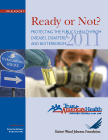More about the Program

Meta-Leadership Summit for Preparedness
The Meta-Leadership Summit for Preparedness was a national initiative designed to empower business, government and nonprofit leaders to work together during a public health or safety crisis. The Summits were launched in 2007 by the CDC Foundation, Centers for Disease Control and Prevention, the National Preparedness Leadership Initiative – Harvard School of Public Health and the Robert Wood Johnson Foundation and concluded in 2011.
More about the Program
Leaders in government, business and nonprofit sectors tend to plan for and respond to emergencies using their own expertise and resources. Occasionally, there may be a significant gap for which they can identify an out-of-sector solution; for example, government frequently depends upon the American Red Cross for sheltering people affected by disasters. 1,2
Typically, preparedness planning and response occurs with limited cross-sector communication or collaboration. 3,4 This reality pointed to the urgent need to create a national cadre of government, business, and nonprofit leaders with a shared vocabulary, approach, and commitment to work across sectors. 5,6 The Meta-Leadership Summits for Preparedness Initiative (MLI) promoted the practice of “Meta-Leadership,” which focuses on preparing leaders with a distinct mindset and a unique set of skills to encourage cross-agency strategic thinking and collaboration. 5,7,8
- Waugh WL & Streib G. Collaboration and Leadership for Effective Emergency Management. Public Administration Review. 2006; 66(S1): 131-140.
- Schoch-Spana M, Franco C, Nuzzo, JB, & Usenza, C. Community Engagement: leadership tool for catastrophic health events. Biosecurity and Bioterrorism: Biodefense Strategy, Practice, and Science. 2007; 5(1): 8-25.
- Von Lubitz DKJE, Beakley JE, & Patricelli F. All hazards approach to disaster management: the role of information and knowledge management, Boyd’s OODA Loop, and network-centricity. Disasters. 2008; 32(4): 561-585.
- Goldsmith S & Eggers WD. Governing by Network: The New Shape of the Public Sector 2004. Washington, DC: Brookings Institution Press; 2004.
- Marcus LJ, Dorn BC, & Henderson JM. Meta-Leadership and national emergency preparedness: a model to build government connectivity. Biosecurity and Bioterrorism: Biodefense Strategy, Practice, and Science. 2006; 4(2): 128-134.
- Ashkenas R, Ulrich D, Jick T, & Kerr S. The Boundaryless Organization: Breaking the Chains of Organizational Structure. San Francisco: Jossey-Bass; 2002.
- Marcus LJ, Dorn BC, & McNulty EJ. Renegotiating health care: Resolving conflict to build collaboration. San Francisco, CA: Jossey-Bass; 2011. http://inkpixelspaper.com/clients/npli/research-resources/negotiation.php
- Marcus LJ, Ashkenazi I, Dorn BC, & Henderson J. The five dimensions of Meta-Leadership. Meta-Leadership Summit website. http://inkpixelspaper.com/clients/npli/research-resources/index.php# Updated November, 2007. Accessed March, 2012.
- Page last reviewed: March 28, 2017
- Page last updated: March 28, 2017
- Content Source:


 ShareCompartir
ShareCompartir

